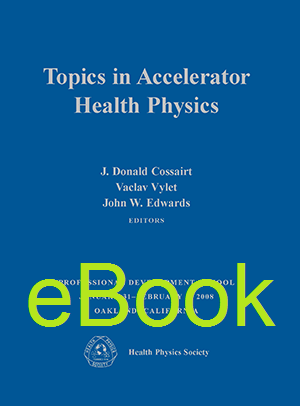
Topics in Accelerator Health Physics, eBook
Author: J. Donald CossairtISBN: 9781930524873
Published: 2008 | 309 pp | eBook
Price: $ 50.00
Health Physics | August 2009, Vol. 97, Number 2
This comprehensive reference document is a compilation of the material presented at the Professional Development School offered in conjunction with the January 2008 Midyear Meeting of the Health Physics Society in Oakland, California. As noted by the editors in their preface, the purpose of the school and this book is to educate the health physics community about the nature of accelerators and accelerator radiation protection. It was their goal to provide a solid background on this topic that can serve as a foundation for further understanding, reading and study. I can assure you that they have done their job well. This 300 page volume with its 13 chapters covers the field of accelerator health physics in an exceptional manner; and the student as well as the experienced professional will find it of considerable value.
Starting with a 45-page summary of the physics and engineering principles of accelerator operation, the book continues with a concise summary of the nature and characteristics of the prompt radiation fields produced at the different types of accelerators. Chapter 3 addresses the types and magnitude of induced radioactivity that is created in accelerator structures, as well as taking an expansive consideration of the potential for creating environmental releases of accelerator produced radioactivity in air, water, and soil.
Following Chapter 4's brief summary of radiation monitoring and measurement practices, Chapter 5 addresses shielding issues at electron and proton accelerators and provides a most useful reference set of key shielding reports for more advanced study by those seeking more information. Chapter 6 provides an extensive compilation of the requirements for radiation safety systems controlling access to accelerator and beam line enclosures, and for monitoring systems controlling abnormal accelerator operations which produce excessive radiation levels in potentially occupiable areas. Chapter 6 is derived largely from the ANSI N43.1 Standard "Radiation Safety for the Design and Operations of Particle Accelerators" and will be a useful section for those concerned about radiation interlock systems at accelerator facilities.
The remainder of the book becomes a tutorial discussion of some highly specialized topical areas within accelerator health physics. Do you wish for more information about synchrotron radiation facilities such as the Stanford Synchrotron Radiation Lightsource or the Brookhaven National Synchrotron Light Source? Or the most advanced light sources utilizing free electron lasers? Take a look at Chapter 7. If you are interested in the use of accelerators in medical radiation therapy, then you will find Chapter 8 very worthwhile.
The challenges of personnel dosimetry and environmental monitoring at accelerator facilities are tackled in Chapters 9 and 10. If you are still trying to sort out the differences between dose equivalent and equivalent dose--take a look at Chapter 9. You will also find a summary of the characteristics of personal dosimeters in use at many accelerator facilities.
A rather detailed discussion of the principles of radiation damage in solids is presented in Chapter 11. This section is theoretical in nature and describes on-going research, but does not delve into practical advice for those wishing to specify radiation resistant materials (e.g., electrical insulation) for new accelerator facilities.
Chapter 12 explores potential health physics challenges that may lie ahead for the accelerator health physicist as new technologies evolve (e.g., x-ray lasers). Chapter 13 focuses heavily on the expectations for managing accelerator facilities funded by the U.S. Department of Energy. Perhaps of greatest interest in this chapter are case studies for four severe radiation injuries that occurred at industrial accelerator facilities between the period 1965-1991. It is always timely to reconsider the lessons learned from past events as we tend to forget the horrendous experience that has formed the basis for our current requirements set. As is usually the case, latent organizational weaknesses in the radiation safety and operational program set the stage for individual errors resulting in severe consequences. Everyone should read and remember why our programs emphasize certain elements. The last chapter also includes six brief case studies highlighting good practices for specific work evolutions at U.S. Department of Energy accelerator facilities.
I believe this book will prove a valuable addition to the library of those interested or involved in the field of accelerator health physics. As would be expected, the material is derived from many other published sources, but it provides a concise compendium of accelerator radiation safety issues that many readers will choose to consult frequently in the future. I highly recommend it.
W. Robert Casey
Brookhaven National Laboratory
Upton, NY


